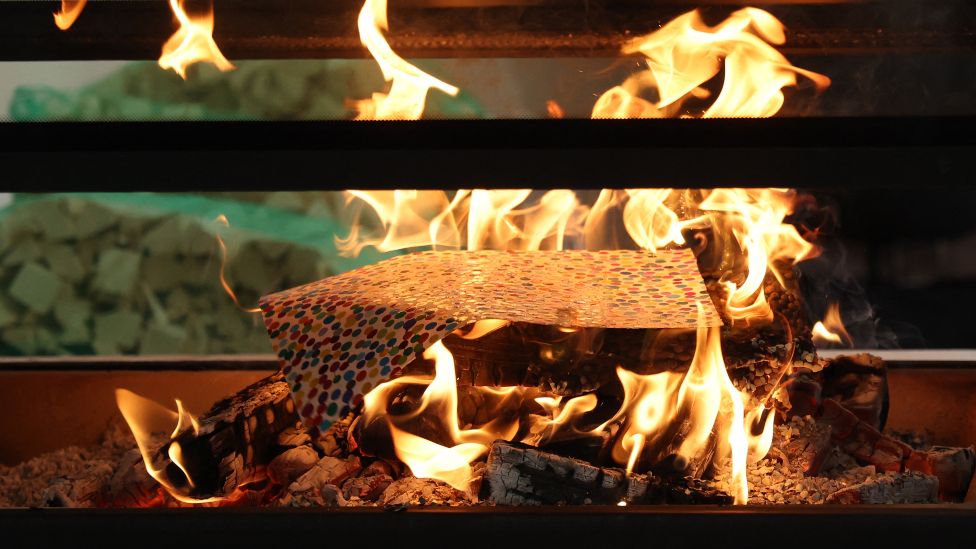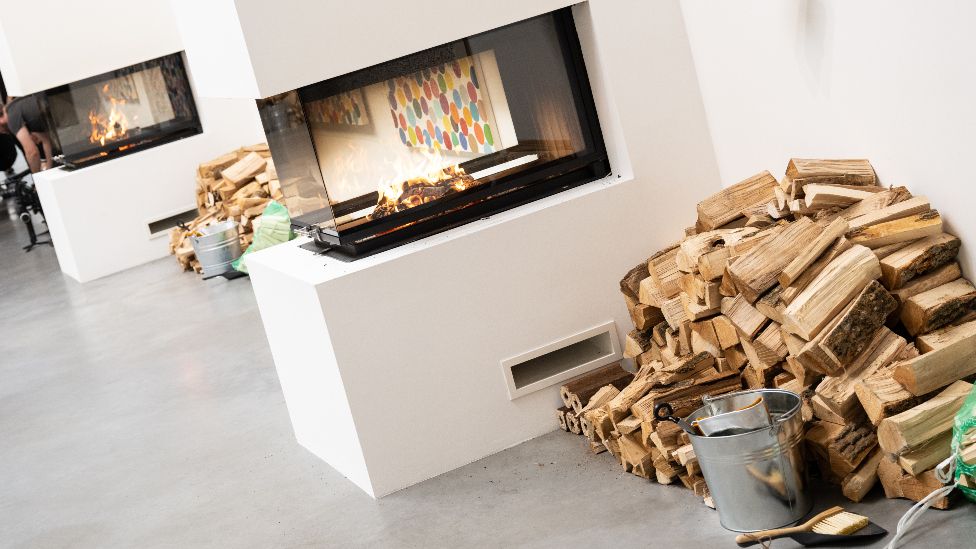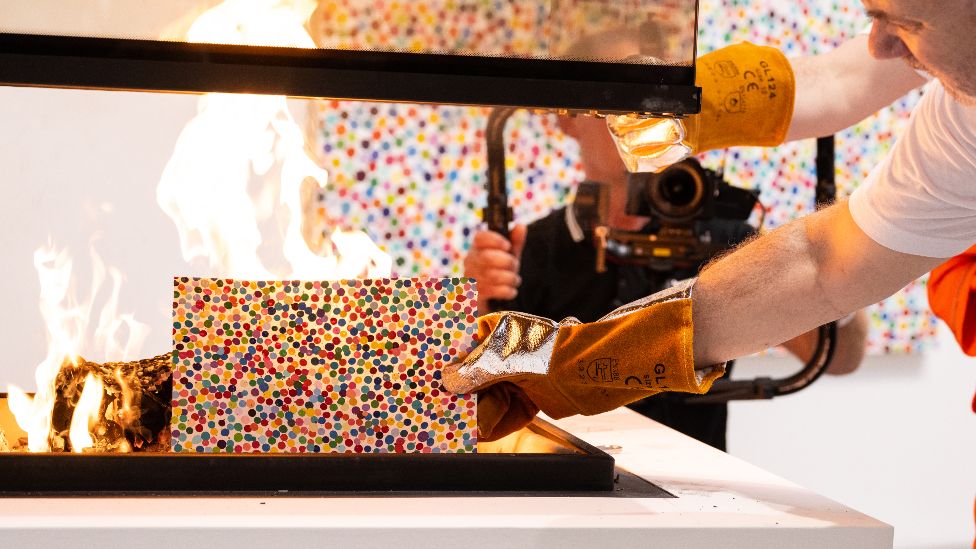Art
Damien Hirst burns his own art after selling NFTs
|
|
Damien Hirst has begun burning hundreds of his own artworks after selling a series of non-fungible tokens (NFTs).
The artist told buyers who bought pieces from his latest collection to choose either the physical artwork or the NFT representing it.
Those who chose the NFTs were told their corresponding physical piece would be destroyed.
The artist was dressed in silver metallic boiler-suit trousers and matching fire safety gloves as he collected each piece and burned it in a contained fire box.
It has been estimated the works being burned are collectively worth almost £10 million.

Getty Images
Hirst launched his first NFT collection last year, called The Currency, which was made up of 10,000 NFTs, corresponding to 10,000 original pieces of art.
Collectors who bought one had to choose between keeping the NFT or swapping it for the physical artwork.
London’s Newport Street Gallery said 5,149 buyers opted for the original artworks while 4,851 chose the NFTs.
Artworks for the non-exchanged NFTs would be destroyed, buyers were informed, with Hirst telling his Instagram followers earlier this week that he would burn the first 1,000 artworks on Tuesday.
The NFTs, which depicted colourful spots, reportedly sold for $2,000 (£1,800) each.
Livestreaming the event, the Turner Prize winner and assistants used tongs to deposit individual pieces stacked in piles into fireplaces in the gallery as onlookers watched.


Getty Images
“A lot of people think I’m burning millions of dollars of art but I’m not,” Hirst said. “I’m completing the transformation of these physical artworks into NFTs by burning the physical versions.
“The value of art, digital or physical, which is hard to define at the best of times will not be lost; it will be transferred to the NFT as soon as they are burnt.”
The artworks were created in 2016 with enamel paint on handmade paper and each numbered, titled, stamped and signed.
They will be burned until The Currency exhibition closes on 30 October.
Before Hirst burned each artwork, he showed it to a camera to log its unique code to keep track of every piece that had been burnt.
Many have criticised Hirst for burning his own valuable artworks during a cost of living crisis.
“I’s almost like Damien Hirst is so out of touch with the real world that he’s basically transcended to another plane of existence, populated only by oligarchs and the once-edgy artists they collect,” wrote Time Out’s Eddy Frankel.
“Still, look at it this way, even if you can’t afford to turn on your heating at home, just go to Newport Street Gallery: it’s free and it should be nice and toasty with all those £20,000 paintings on fire.”


Getty Images
Hirst, who is no stranger to what some critics describe as publicity stunts, rose to fame during the 1990s Young British Artist scene.
He picked up the Turner Prize in 1995 and his work has sold for millions, but he is also one of Britain’s most controversial artists.
Much of his work has divided critics, including one featuring a dead shark floating in formaldehyde and another consisting of a bisected cow and calf.
The 57-year-old is also known for his spot paintings and “For The Love Of God”, a platinum cast of an 18th-century human skull encrusted with diamonds.
Speaking to the BBC about his art in 2018, he said: “If I put it in a skip outside a pub, would someone take it home? And you think, ‘yeah, they would.’ If it’s good, it won’t get left in the street. I think that’s a good way of working out if a painting’s good or not.”


Getty Images
NFTs are “one-of-a-kind” assets in the digital world that can be bought and sold like any other piece of property, but which have no tangible form of their own.
The digital tokens can be thought of as certificates of ownership for virtual or physical assets.
Traditional works of art such as paintings are valuable precisely because they are one of a kind.
But digital files can be easily and endlessly duplicated.
With NFTs, artwork can be “tokenised” to create a digital certificate of ownership that can be bought and sold.
NFTs soared in popularity last year as crypto-rich speculators sought to cash in on rising prices but sales volumes have fallen more recently.
Art
Meet artist J-Positive and the family behind his art store – CBC.ca


- 1 day ago
- News
- Duration 4:42
Joel Jamensky’s sunny disposition explains why the artist with Down syndrome uses the name ‘J-positive’ for his online art business, started with the help of his parents two years ago. “There’s a lot more going on in [Joel’s] art than may be at first glance – just like him,” said his dad, Mark.
Art
Made Right Here: Woodworking art – CTV News Kitchener
[unable to retrieve full-text content]
Made Right Here: Woodworking art CTV News Kitchener




Source link
Art
5 Ways Galleries Are Making the Art World Greener – Artsy
Art Market
Maxwell Rabb
Apr 22, 2024 12:00PM
Exterior view of Oudolf Field at Hauser & Wirth Somerset. Photo by Jason Ingram. Courtesy of Hauser & Wirth.
This year’s Earth Day comes against a stark backdrop. Last year was the warmest on record, and a recent UN climate report recently warned that it’s “now or never to limit global warming.”
As the impacts of climate change grow increasingly urgent, the art community is recognizing its role in addressing environmental challenges through various initiatives and practices. Among the most significant of these is the Gallery Climate Coalition (GCC), founded in 2020, which unites a network of galleries in their commitment to sustainability. The organization—comprising over 900 members—emphasizes how galleries can collectively help to curb environmental damage.
Hauser & Wirth, a prominent member of the GCC, is one of the galleries spearheading these changes, committing to halve its emissions by 2030, which aligns with the 2015 UN Paris Agreement and the GCC’s mission statement.
Portrait of Cliodhna Murphy. Courtesy of Hauser & Wirth.
Portrait of Charles Moffett. Photo by Charlie Rubin. Courtesy of Charles Moffet.
Advertisement
“We are working in an industry that has entrenched habits and behaviors, and we need to steadily identify ways in which to shift the dial,” said Cliodhna Murphy, Hauser & Wirth’s global head of environmental sustainability. “I have been regularly meeting with a group of like-minded individuals from galleries of scale to discuss how we standardize the approach to sustainability across the art world, working towards the same goals. This is something that the GCC is also active in promoting in order to create a level playing field across all of the galleries and how they report their findings.”
In recognition of Earth Day, Artsy spoke with six galleries to identify five key ways that they are making strides toward a greener future.
Introducing greener shipping solutions
Interior view of Hauser & Wirth Downtown Los Angeles, 2019. Photo by Elon Schoenholz. Courtesy of Hauser & Wirth.
The use of air travel to transport artworks is one of the pivotal practices being addressed by galleries to mitigate their environmental impact. The use of sea freight—which, according to the GCC, is 60 times less environmentally damaging than air transportation—is one of the main shifts that is taking place in this regard.
Hauser & Wirth is among the galleries using sea freight for transporting its high-value artworks. “There is a long-held preconception that sea freight is not an option for high-value painting, but I discovered that with the right crating, insurance, and remote supervision, it is absolutely a viable route,” Murphy told Artsy. “As a result, last year, we saved 200 [equivalent tonnes of] carbon dioxide by shifting six exhibitions to sea freight. That’s equivalent [to] 150 return economy flights between London and New York.”
Echoing this commitment, Roberts Projects’s senior registrar and sustainability liaison, Siobhan Bradley, revealed that the most considerable way the Los Angeles–based gallery has improved is through its packing and shipping methods—specifically by introducing alternative packing materials, reusing crates, and consolidating shipments. By doing so, the gallery has cut both environmental and financial costs. “These changes have been well received, particularly because they are generally cost-saving,” Bradley told Artsy.
Taking direct action with benefit exhibitions
Portrait of Quang Bao. Courtesy of 1969 Gallery.
Several galleries are integrating environmental issues into their exhibition programs by hosting benefit exhibitions that directly tackle climate change. One example is Tribeca’s 1969 Gallery, which recently hosted “World Beyond World” from January 18th to February 24th this year. This exhibition brought together 20 artists to support ocean conservation. Proceeds were donated to Only One, a nonprofit based in New York dedicated to restoring ocean health and addressing the climate crisis.
“Eric Oglander has these wonderful sculptural jars filled with an entire ecosystem of algae, snails, and plant life,” said the gallery’s founder, Quang Bao, reflecting on the exhibition. “We had to help keep the jars clean, lit over the days we were closed to help photosynthesis along. I loved them, and I think visitors, especially children, seemed to understand the deeper lesson—that you really have to handle the world we live in with conscience and handheld care.”
Eric Oglander, Jar 4, 2024. Courtesy of 1969 Gallery.
Eric Oglander, Jar 2, 2024. Courtesy of 1969 Gallery.
Charles Moffett is another gallery taking a similar approach. The New York gallery is currently gearing up for its own benefit exhibition next month, working closely with Art to Acres, an initiative focused on funding high-integrity conservation projects worldwide. The show, titled “Not Too Late,” will run from May 3rd to June 7th and will feature all 10 of the gallery’s represented artists, among several others. “[Art to Acres] is converting the actions of what we do in the art world into meaningful change,” founder Charles Moffet told Artsy.
Hauser & Wirth is also hosting an Earth Day 2024 event with Art to Acres, where artist Mika Rottenberg will release a series of lamps. Proceeds will benefit both Art to Acres and the artist’s innovative studio in Tivoli, New York, where she employs plastic reclamation to create her fantastical and playful sculptures with intrusive vines in the Hudson Valley forests.
“One single artist studio or gallery can’t shift the landscape, but collective action amplifies our efforts, builds a movement, and contributes to climate resilience,” said Murphy, referencing that several of the gallery’s artists have embraced sustainable practices, including Anj Smith, Pipilotti Rist, and Larry Bell.
Advocating for sustainable supply chains
Exterior view of Cristea Roberts Gallery. Photo by Jack Hems. Courtesy of Cristea Roberts Gallery.
Actively reducing everyday waste is another way galleries are embedding sustainability practices into their operations. London’s Cristea Roberts Gallery, for example, is taking strides in integrating sustainable materials into its day-to-day operations. Alan Cristea, co-director of the gallery, noted that the gallery is focused on reducing energy consumption and has actively banned polystyrene and reduced single-use plastics in favor of sustainable materials.
“There is still much work to be done, but by opening up conversations and making changes, however small, we hope to build long-term momentum for a sustainable art sector,” said Cristea. “Galleries are also in a unique position to leverage collectors, shipping partners, and the art sector in general to consider working in more permanent, environmentally responsible ways.”
Exterior view of Charles Moffett. Photo by Andy Romer. Courtesy of Charles Moffett.
Often, by switching to sustainable materials and making conscious everyday decisions, galleries and their artists are making a difference. “It’s been really incredible to watch a lot of galleries and artists become more invested in more sustainable practices, whether it’s as simple as changing how we get our power or changing the way in which we ship,” noted Moffett. “These small efforts do tend to have a ripple effect in a business and the art world.”
By implementing these measures, these galleries are both minimizing their environmental impact and influencing the art supply chain to adopt greener practices.
Encouraging online engagement
Portrait of Todd Hosfelt. Courtesy of Hosfelt Gallery.
Portrait of Alan Cristea. Courtesy of Cristea Roberts Gallery.
As digital technologies evolve, so do opportunities for reducing physical travel. Alan Cristea notes that the biggest leap for galleries is circumventing industry norms—which often demand environmentally taxing methods.
Since the COVID-19 pandemic halted the international art world circuit, galleries have become accustomed to exhibiting and selling art online. This also extends to their outreach when it comes to building and maintaining relationships with clients worldwide. In San Francisco, Hosfelt Gallery has drastically reduced unnecessary travel by supplementing in-person meetings with online interactions.
Exterior view of Hosfelt Gallery. Courtesy of Hosfelt Gallery.
“The worst thing any of us do is fly,” founder Todd Hosfelt said. “We need to do less of it. Instead of hopping on a plane for every event, ask, ‘What do you hope to achieve by going?’ and ‘Can you achieve it without flying there?’ In other words, is that trip actually necessary? I used to fly all over the world to do studio visits or meetings….Now, I mostly use Zoom. How many staff people do you really need at an art fair? Can you tack your holiday plans onto the front or back of a work trip? I’m not suggesting never flying anywhere; I’m saying do it thoughtfully.”
Spreading awareness
Exterior view of Roberts Projects. Photo by Eric Staudenmaier. Courtesy of Roberts Projects.
The more people that know about how to make their businesses sustainable, the wider adoption will be. From learning about auditing their environmental impact to getting involved with organizations like Art to Acres and the GCC, gallerists are making each other aware of what they can do. “A big part of it is just education, and awareness, for me, is the first building block in all of this,” said Moffet. “If you don’t understand the impact of your gallery or your museum or your organization, you don’t know what it is that needs to happen in order to reduce your footprint,” he noted.
Programs that address environmental issues—whether in fair-funded talks or action-oriented gallery exhibitions—are crucial ways of fostering a culture of sustainability, which is essential to empowering sustainable action across the art world.
“Galleries—especially members in senior positions—should fully support their staff’s interest in sustainability,” said Robert Projects’s Bradley. “To me, this means creating and allocating time for staff to do research, attend educational seminars or meetings with environmental groups, and then genuinely listening to what they’ve learned and what they feel can be implemented at individual galleries.”
Maxwell Rabb
Maxwell Rabb is Artsy’s Staff Writer.
-
Business14 hours ago
Honda to build electric vehicles and battery plant in Ontario, sources say – Global News
-



 Science14 hours ago
Science14 hours agoWill We Know if TRAPPIST-1e has Life? – Universe Today
-
Investment17 hours ago
Down 80%, Is Carnival Stock a Once-in-a-Generation Investment Opportunity?
-



 Health14 hours ago
Health14 hours agoSimcoe-Muskoka health unit urges residents to get immunized
-



 Health11 hours ago
Health11 hours agoSee how chicken farmers are trying to stop the spread of bird flu – Fox 46 Charlotte
-
News19 hours ago
Honda expected to announce multi-billion dollar deal to assemble EVs in Ontario
-



 Sports24 hours ago
Sports24 hours agoJets score 7, hold off Avalanche in Game 1 of West 1st Round – NHL.com
-



 Tech18 hours ago
Tech18 hours agoIndigenous Craft and Vendors Market a success in Halifax




